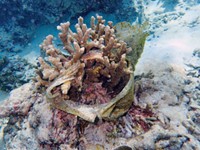Advertisement
Grab your lab coat. Let's get started
Welcome!
Welcome!
Create an account below to get 6 C&EN articles per month, receive newsletters and more - all free.
It seems this is your first time logging in online. Please enter the following information to continue.
As an ACS member you automatically get access to this site. All we need is few more details to create your reading experience.
Not you? Sign in with a different account.
Not you? Sign in with a different account.
ERROR 1
ERROR 1
ERROR 2
ERROR 2
ERROR 2
ERROR 2
ERROR 2
Password and Confirm password must match.
If you have an ACS member number, please enter it here so we can link this account to your membership. (optional)
ERROR 2
ACS values your privacy. By submitting your information, you are gaining access to C&EN and subscribing to our weekly newsletter. We use the information you provide to make your reading experience better, and we will never sell your data to third party members.
Pollution
Ocean Plastics Host Surprising Microbial Array
Environment: Some microbes living on plastic waste may help break down the materials
by Mark Schrope
June 17, 2013

A surprising suite of microbial species colonizes plastic waste floating in the ocean, according to a new study. These microbes could speed the plastic’s breakdown but might also cause their own ecological problems, the researchers say (Environ. Sci. Technol. 2013, DOI: 10.1021/es401288x).
Plastic waste from consumer products often finds its way into the oceans in a range of sizes, from microscopic particles to large chunks. This accumulation of plastic worries environmental scientists. For example, fish and marine mammals can mistake the plastic pieces for food and ingest the debris, or toxic chemicals can leach from the plastics.
But much still remains unknown about the ecological impacts of these materials. So a group of Massachusetts researchers, led by Linda A. Amaral-Zettler at the Marine Biological Laboratory and Tracy J. Mincer at Woods Hole Oceanographic Institution, decided to study the microbial communities found on plastics to explore how the organisms affect marine environments.
The team analyzed plastic samples they collected during two research cruises to the North Atlantic Subtropical Gyre, a stretch of ocean roughly midway between the eastern coast of North America and Africa. They used a scanning electron microscope, among other techniques, to study the bacteria living on the particles. “What we found really blew us across the room,” says Mincer, a microbial ecologist: They couldn’t say for sure, but the bacteria appeared to burrow pits into the plastic, which had never been observed before. The team didn’t expect such behavior, because they thought nutrient levels in that region wouldn’t support bacteria digesting hydrocarbons in this way.
The group suspects this may at least partially explain a surprising aspect of plastic waste found in previous studies in this region of the Atlantic. Even though the amount of plastic waste entering the ocean is probably increasing, researchers at Sea Education Association, a nonprofit group that studies the ocean environment, have not found an increase in plastics in the sea (Science 2010, DOI: 10.1126/science.1192321).
Mincer says one possible explanation is that bacteria eat into the polymers, weakening the pieces enough to cause them to break down more quickly and eventually sink to the sea floor. Supporting this hypothesis, some of the plastic-burrowing bacteria are closely related to species known to consume other types of hydrocarbons, such as oil.
Because of the possible risks the debris poses to marine life, microbes breaking down plastic pollution would be a promising discovery, says Michael Cunliffe, a marine microbiologist at the Marine Biological Association of the United Kingdom. “But it needs to be shown in a bit more detail.”
Besides the bacterial pits, the team also found evidence that the microbial communities on plastics were distinct from those found in surrounding waters. A single sample a few centimeters across could contain hundreds of microbial species. “It’s really like a microbial reef,” Mincer says.
The team is currently analyzing samples collected during a cruise in the Pacific. They want to determine whether there are significant differences in those bacterial communities compared to the ones on Atlantic plastics.
Mincer and his colleagues also want to investigate whether microbe activity might liberate toxic chemical additives to plastics, such as flame retardants, which have been linked to health risks. Another possibility, Cunliffe points out, is that microbial film growth could shield the chemicals’ release.
The North Atlantic study is a good start, Cunliffe says, but he has reservations about drawing conclusions too quickly. In particular, he says researchers must determine whether bacterial communities on plastics are unique or similar to those that might be found on other floating material such as wood. “If not,” he says, “It’s just another surface in the ocean.”





Join the conversation
Contact the reporter
Submit a Letter to the Editor for publication
Engage with us on Twitter